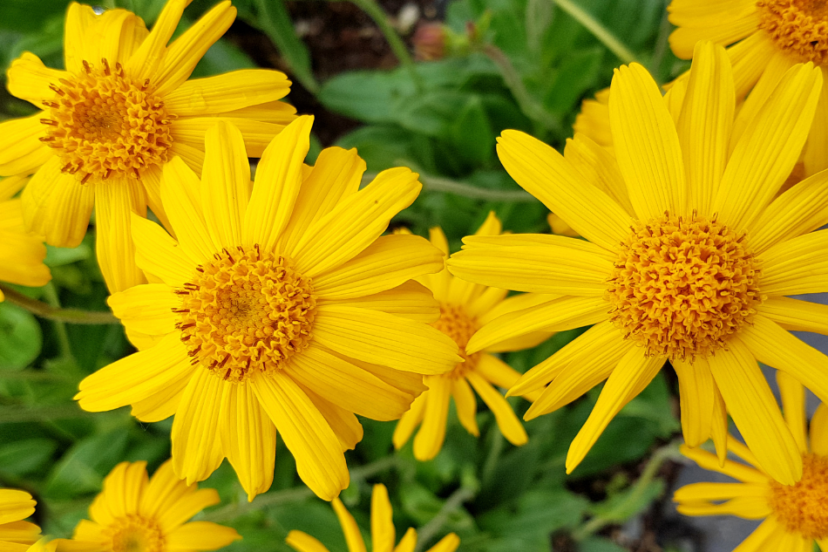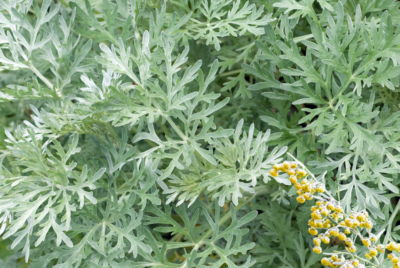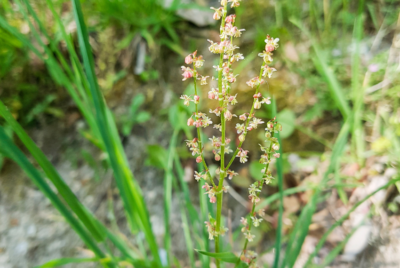Arnica Oil
Arnica Oil
1. The Perfect Herb For Athletic Recovery And Muscle Pain
Overloaded muscles and post-workout soreness are common struggles for athletes and fitness enthusiasts. Luckily, Arnica oil, cream or slave is here to help speed up recovery and alleviate muscle pain. This powerful herb has anti-inflammatory, analgesic, and healing properties that make it a go-to natural remedy for relieving aches and pains. Whether you’re dealing with a sports injury or just looking to recover faster after a tough workout, Arnica oil, arnica salve or cream is a safe and effective solution to consider. Learn more about the benefits of Arnica and how it can enhance your athletic performance and overall well-being.
No products found.
1.1 Key Takeaways: about arnica oil, creams, ointments and slave.
- Arnica is a perfect herb for athlete recovery and easing muscle pain.
- Arnica has anti-inflammatory properties that can help reduce swelling and pain.
- It can be used in various forms such as creams, gels, or ointments for easy application.
- Arnica can speed up the healing process by increasing circulation to the affected area.
- Consult with a healthcare professional before using Arnica to ensure it is safe for your specific needs.
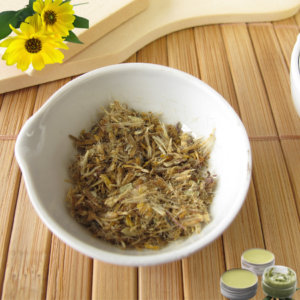
Product shop coming soon…
2. Understanding an athletes journey.
The journey to athletic excellence is filled with challenges, triumphs, and yes, muscle pain. Whether you’re a seasoned athlete or just starting your fitness journey, understanding the intricacies of muscle pain and the recovery process can make all the difference in achieving your goals.
2.1. Physiology of Muscle Pain
For athletes, muscle pain is more than just a physical sensation – it’s a reminder of the hard work and dedication that goes into training. When you push your body to its limits, microscopic tears occur in the muscle fibers, leading to inflammation and soreness. This process, known as delayed onset muscle soreness (DOMS), is a sign that your muscles are adapting and getting stronger.
It’s important to distinguish between normal muscle soreness and pain caused by injury. While mild discomfort after a workout is expected, sharp or persistent pain may indicate a more serious issue that requires medical attention.
- SORE MUSCLE MASSAGE OIL FOR MASSAGE THERAPY – Our 100% Natural formula, expertly crafted to help alleviate tired, aching muscles. With its easy absorption and natural aroma, this oil helps eases tension while leaving your skin feeling deeply nourished and moisturized.
- ARNICA OIL & PEPPERMINT OIL – Both possess soothing properties that make them beneficial for muscle relief. Combining these two oils helps provide a synergistic effect, offering both immediate relief from discomfort and long-term benefits for muscle recovery and relaxation.
- MADE WITH ALL-NATURAL POWERFUL INGREDIENTS – Made with a blend of all-natural ingredients, including Arnica Extract, Lavender Oil, Peppermint Oil & Chamomile Oil specifically designed to targets sore muscles and joints while inducing relaxation.
- NON-GREASY & LIGHTWEIGHT – This fast-absorbing formula, effortlessly melts into the skin for a silky-smooth texture. Infused with a refreshing mint scent our massage oil with its natural soothing aroma, bids farewell to greasy residues.
- CRUELTY, PARABEN, SULFATE, AND PHTHALATE FREE – This massage oil for sore muscles is cruelty-free and made with clean ingredients, so that we can ensure a safer and more ethical choice for our customers, promoting both their well-being and that of the environment.
- M3 Naturals anti cellulite body massager oil can help moisturize and tighten cellulite from your belly, thighs, and buttocks while also providing much needed comfort to sore and tired muscles
- Enjoy peppermint and arnica oil for muscle and joint benefits plus stem cells and collagen oil for skin tightening and anti aging results so you can look and feel your best with potent ingredients
- Firm your skin and ease your muscles with our cellulite and sore muscle massage oil for body care packed with pure essential oils and experience a one of a kind multipurpose arnica oil massage formula
- Our massage cream alternative is for all bodies and skin types and is quickly absorbed for day or night use - For best results pair with our anti cellulite massager, body scrubs, and massage tools
2.2. The Recovery Process
Pain is a natural part of the athletic journey, but so is the recovery process. Proper recovery is important for muscle growth, injury prevention, and overall performance improvement. This period of rest allows your muscles to repair and rebuild, ultimately making you stronger and more resilient.
2.3. Strategies such as adequate rest, hydration, nutrition, and stretching play a crucial role in enhancing your body’s ability to bounce back from intense workouts. In addition to these fundamental practices, incorporating herbal remedies like arnica into your recovery routine can provide natural relief from muscle pain and inflammation.
As far as the recovery process, it’s important to listen to your body and give it the care and attention it deserves. Keep in mind, recovery is not a sign of weakness, but rather a smart and proactive approach to long-term athletic success.
- Pure Essential Oil Works Arnica Oil provides immediate relief to tired, overworked muscles. It is perfect to use after a busy day or a strenuous workout, and can also be used as a daily skin softener.
- All-Natural Arnica Oil: Paraben-free. It relieves pain, bruising & promoting hair growth.
- Grade Oil: This paraben-free oil can be used in any shampoo, conditioner, body wash, bath gel or other skin care product. It is a oil that relaxes, soothes and instills positivity.
- Massage Oil: Arnica Oil captures the natural soothing essence of Arnica & can be used as a massage oil. It has to be diluted with any of your favorite essential oils prior to massaging into skin.
- Arnica Oil Aroma: This natural Arnica Oil has a bitter and herbal aroma. It is easily absorbed, non-greasy & doesn’t clog pores.
- Expertly prepared from the certified organic and/or sustainably wildcrafted whole flower of Arnica montana plants.
- Extracted into certified organic cold-pressed Olive oil.
- Thoroughly screened for synthetic herbicides and pesticides, heavy metals, bacteria, yeast and mold.
- For external use only.
- Pampers for body comfort. Arnica oil is a soothing carrier oil that may help comfort tired bodies, perfect for post-workout aftercare. Use 2-3 drops in an arnica oil massage on back, shoulders or knees.
- Improves appearance of softer-looking hair. Arnica oil may also provide ample nourishment that may promote soft and smooth-looking hair. Apply 3-4 drops on hair as is to use it as an arnica hair oil.
- Handpicked & extracted. Made with Mexican arnica flowers, our arnica oils goes through a rigorous step-by-step process from drying to steeping in olive oil to preserve its natural benefits.
- Tested for safety and quality by MSDS. Seek medical advice before using on pets, infant or during pregnancy. Our carrier oils are mainly composed of natural botanicals, a patch test for safety is recommended.
3. The Healing Properties of Arnica

Some plants possess remarkable healing properties, and arnica is no exception. Arnica, also known as Arnica montana, has been used for centuries as a natural remedy for a variety of ailments, particularly muscle pain and bruises. This herb is native to Europe but is now grown in various parts of the world for its medicinal benefits.
3.1. Active Ingredients in Arnica
One of the key components of arnica that contributes to its healing properties is helenalin, a sesquiterpene lactone that has anti-inflammatory and analgesic properties. This compound helps reduce pain and swelling, making arnica an excellent choice for treating muscle soreness and joint pain. In addition to helenalin, arnica also contains flavonoids, which further contribute to its anti-inflammatory effects.
Arnica also contains thymol derivatives, which have antimicrobial properties, making arnica beneficial for treating wounds and skin infections. The combination of these active ingredients makes arnica a potent natural remedy for various conditions.
- Effective cracked hands and feet repair, clinically tested and proven to provide 24 hour moisture for dry and rough skin. We love to use it to heal feet, elbows and dry hands that crack. Deep and intense moisturizing healing foot Salve
- Fast, soothing relief for dry skin, use as a foot cream to repair dry cracked feet, or as a hand repair cream. This multi-purpose moisturizer is sure to calm, soothe and refresh severely cracked and dry skin!
- With naturally-derived ingredients sourced from around the globe perfect for cracked skin repair salve
- Apply liberally as many times as needed to areas with dry and rough skin such as your hands, feet, knees, elbows. For extremely dry feet , apply the salve at night before bedtime, and keep your socks on to lock the moisture in overnight
- Never Tested on Animals (We love them!) This intensive healing cracked skin treatment has been allergy tested and does not contain artificial fragrance or artificial colors. Made in USA.
- SOOTHE SORENESS: This powerful blend of Arnica and Clove oil is gentle on your skin.
- ARNICA & CLOVE OIL: This salve offers soothing and nourishing benefits for your skin, supporting overall wellness.
- VERSATILE USES: Suitable for athletes, fitness enthusiasts, or anyone experiencing everyday aches, this salve can be use whether at home, at the gym, or on the go
- HANDCRAFTED: No shortcuts are taken when creating each and every jar of salve. Every single jar of MJ’s Herbals has been carefully and lovingly handmade and smiled upon by MJ herself.
- INGREDIENTS: Organic arnica flowers and organic essential oil of clove infused in a base of certified organic olive oil and unrefined propolis beeswax. CAUTION: Do not use arnica salve on broken skin.
- Essential Herbal Formula Supports Natural Comfort for Sore Muscles, Stiffness, and Skin Appearance
3.2. How Arnica Alleviates Muscle Pain
One of the ways arnica alleviates muscle pain is by increasing circulation to the affected area. Improved blood flow helps reduce inflammation and promotes healing, helping muscles recover faster after intense physical activity. Arnica also helps soothe muscle spasms and stiffness, providing relief from discomfort.
Active individuals and athletes often use arnica as a topical treatment for muscle pain and soreness. Arnica-based creams and gels are readily absorbed into the skin, delivering the herb’s healing properties directly to the affected muscles. This targeted application allows for quick and effective relief from muscle pain, making arnica a popular choice among those seeking natural remedies for athletic recovery.
Plus, arnica is considered safe for most people when used topically as directed. However, it is crucial to avoid applying arnica to broken skin or open wounds, as it may cause irritation. Incorporating arnica into your post-workout routine can help you recover faster and get back to your activities with less pain and discomfort.
- Arnica-Powered: Reduce the appearance of bruising and discomfort with our Arnica-Infused Moisturizing Oil. Deep long-lasting relief meets arnica extract, surpassing the effects of traditional arnica gel, for targeted relief and skin rejuvenation.
- Vitamin-Enriched Radiance: Unlock your skin's natural glow with our Vitamin K & E Radiance Infusion. Diminish discoloration while restoring even skin tone for a revitalized complexion. Better than bruising cream. Extra strength fast healing thin skin
- Botanical Nourishment: Indulge in botanical bliss with our blend of Abyssinian, Argan, Meadowfoam, and Green Tea Oil, each serving a specific purpose designed to deliver real and long lasting results
- Youthful Vitality: Harness the power of Licorice Root Extracts and Ginseng to restore youthful softness and suppleness. Promote vitality for a luminous complexion that radiates with health.
- Advanced Arnica Penetration: Experience the Arnica Powerhouse with our revolutionary oil. Penetrating deeply, it surpasses traditional creams for rapid relief and optimal skin health.
4. How to Use Arnica Oil for Recovery
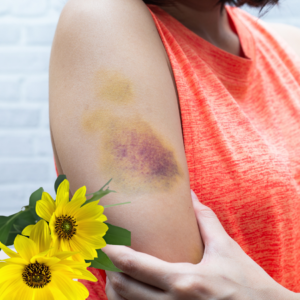
Not sure how to incorporate arnica into your recovery routine? Here are some tips on how to use this powerful herb to help with athletic recovery and muscle pain.
4.1. Topical Arnica Products
Any athlete can benefit from using topical arnica products for targeted relief. Arnica oil, creams, gels, and ointments can be applied directly to sore muscles or bruises to help reduce inflammation and promote healing. Simply follow the instructions on the packaging for best results. These products are convenient to use and can easily be added to your post-workout routine.
For a more concentrated effect, consider using arnica-infused oils for massage therapy. This can help target specific areas of tension and soreness, providing a soothing and relaxing experience.
- ARNICA FOR PAIN: This homeopathic medicine helps temporarily relieve muscle pain & stiffness due to minor injuries, overexertion & falls. Also great for pain, swelling, & discoloration from bruises.
- TOPICAL PAIN RELIEF: Our non-greasy, water-based formula absorbs quickly & is unscented & paraben-free. This cooling gel is great for relief following an injury, intense workout, or general overexertion.
- PLANT-BASED ACTIVE INGREDIENT: The Arnica montana plant is a natural pain reliever. This popular homeopathic medicine temporarily relieves muscle pain & stiffness without unwanted drowsiness.Fluoride-Free
- HOMEOPATHIC MEDICINE uses highly diluted biological, botanical, or mineral substances to relieve symptoms. Our tablets, pellets, & topical treatments work with your body without the risk of contraindications, or known drug interactions.
- THE BOIRON PROMISE: We believe there’s more than one way to feel better. Since 1932, we have been committed to providing quality medicines. As a world leader in homeopathy, our passion is your health. Our promise is your satisfaction.
- ALL-NATURAL PAIN RELIEF: Clinical strength homeopathic Arnica Gel Plus 15 healing plant compounds helps relieve muscle pain & stiffness due to overexertion, minor injuries and falls. Also, widely used for pain, swelling and discoloration from bruises after surgery. Can be used with other pain medicines or supplements without risk of drug interactions or complications.
- RELIEF FROM BODY PAIN & BRUISING: Eases muscle soreness and stiff joints*
- SKIN IRRITATION RELIEF: Relieves skin irritations, rashes, bites & stings*
- COMFORT FROM body aches & pains from overuse, help with sports & fitness recovery, and supports wound healing after surgery*
- PHYSICIAN FORMULATED & RECOMMENDED: VitaMedica’s wellness products have been trusted by plastic surgeons for over 25 years to speed the recovery of swelling, bruising, and pain from surgeries and cosmetic procedures. Our Arnica Montana cream, gel, and tablets naturally promote quicker recovery time and alleviate pain and discomfort through plant-based, homeopathic therapy.
- ARNICA FOR PAIN: This homeopathic medicine helps temporarily relieve muscle pain & stiffness due to minor injuries, overexertion & falls. Also great for pain, swelling, & discoloration from bruises.
- TOPICAL PAIN RELIEF: Our non-greasy, water-based formula absorbs quickly & is unscented & paraben-free. This cooling gel is great for relief following an injury, intense workout, or general overexertion.
- PLANT-BASED ACTIVE INGREDIENT: The Arnica montana plant is a natural pain reliever. This popular homeopathic medicine temporarily relieves muscle pain & stiffness without unwanted drowsiness.
- HOMEOPATHIC MEDICINE uses highly diluted biological, botanical, or mineral substances to relieve symptoms. Our tablets, pellets, & topical treatments work with your body without the risk of contraindications, or known drug interactions.
- THE BOIRON PROMISE: We believe there’s more than one way to feel better. Since 1932, we have been committed to providing quality medicines. As a world leader in homeopathy, our passion is your health. Our promise is your satisfaction.
4.2. Oral Arnica Supplements
On top of topical applications, oral arnica supplements can also support recovery from within. Arnica tablets or capsules can be taken as directed to help reduce muscle pain and stiffness after intense workouts. These supplements can aid in overall muscle recovery and promote a quicker return to peak performance.
With the growing popularity of natural remedies for athletic recovery, oral arnica supplements offer a convenient and effective way to support your body’s healing process. When used in combination with topical arnica products, you can experience the full benefits of this potent herb.
- SAFE, GENTLE & EFFECTIVE: Your holistic recovery journey begins here. Gentle on the stomach with no chalky aftertaste or known drug interactions, VitaMedica’s Arnica Montana 30X HPUS potency tablets are ideal for soothing mild to general pain and provide clinical-grade support for surgery, injury, bruising, and swelling.
- CLINICAL-STRENGTH NATURAL PAIN SUPPORT: Soothe pain due to surgery, injury, bruising, and swelling with VitaMedica’s botanically-derived, chemical-free, natural arnica tablets. Blending modern science with holistic wisdom, our Arnica Montana 30X tablets are sourced from real Arnica Montana flowers using standard homeopathic processes guided by the FDA.
- ARNICA FOR BRUISING AND SWELLING: Feel better faster after surgery or injury with this soothing holistic bruise and swelling reducer. Arnica 30X homeopathic potency is ideal for bruising and swelling from soft tissue trauma on the face, neck, and body.
- ARNICA MONTANA HOMEOPATHIC TABLETS: Ease pain and discomfort fast with quick-dissolving, all-natural Arnica Montana tablets to aid in athletic recovery and stimulate the body’s natural restorative processes after surgical procedures and injury.
- PHYSICIAN FORMULATED & RECOMMENDED: VitaMedica’s wellness products have been trusted by plastic surgeons for over 25 years to speed the recovery of swelling, bruising, and pain from surgeries and cosmetic procedures. Our Arnica Montana cream, gel, and tablets naturally promote quicker recovery time and alleviate pain and discomfort through plant-based, homeopathic therapy.
- ARNICA FOR PAIN: This homeopathic medicine helps temporarily relieve muscle pain & stiffness due to minor injuries, overexertion & falls. Also great for pain, swelling, & discoloration from bruises.
- EASY TO TAKE: Arnicare pellets provide general pain relief & may be combined with an Arnicare topical for targeted relief. Our pellets quickly dissolve under the tongue; no water or chewing required.
- PLANT-BASED ACTIVE INGREDIENT: The Arnica montana plant is a natural pain reliever. This popular homeopathic medicine temporarily relieves muscle pain & stiffness without unwanted drowsiness.
- HOMEOPATHIC MEDICINE uses highly diluted biological, botanical, or mineral substances to relieve symptoms. Our tablets, pellets, & topical treatments work with your body without the risk of contraindications, or known drug interactions.
- THE BOIRON PROMISE: We believe there’s more than one way to feel better. Since 1932, we have been committed to providing quality medicines. As a world leader in homeopathy, our passion is your health. Our promise is your satisfaction.
- NSAID-FREE PAIN RELIEF: Find relief without the use of NSAIDs. Arnicare Tablets are formulated to provide relief for muscle pain, stiffness, swelling from injuries, and bruises.* For added relief, pair with any Arnicare topical product.
- MELT AWAY PAIN: Arnicare Pain Relief Tablets melt in your mouth without the need for water and can be taken on an empty stomach. Simply let the tablets dissolve in your mouth to experience relief from everyday aches and pains.
- HELP YOUR BODY THE NATURAL WAY: Arnicare Pain Relief Tablets have no known interactions with other medications or supplements and no contraindications. Gluten-free and no artificial sweeteners, flavors, colors, or preservatives.
- A TRUSTED BRAND: With over 90 years of expertise, Boiron is the Arnica expert. Boiron medicines are made in FDA-inspected facilities and meet the highest standards of cGMP and HPUS for purity and quality.
- BUY WITH HSA/FSA: Boiron Arnicare pain relievers are HSA & FSA eligible in the U.S.
5. Precautions and Best Practices
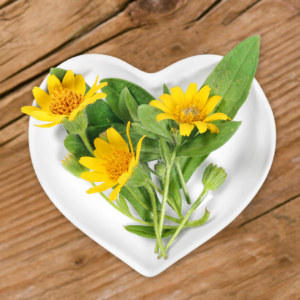
5.1. When Not to Use Arnica
Despite the many benefits of Arnica for muscle pain and athletic recovery, there are some situations where it is not recommended to use this herb. If you are allergic to plants in the Asteraceae family, such as ragweed or daisies, you should avoid using Arnica as it may cause an allergic reaction. Additionally, Arnica should not be applied to broken skin or open wounds as it can irritate the skin and cause further inflammation.
Practices It is also important to avoid using Arnica internally, as it can be toxic if ingested in large amounts. Pregnant or nursing women should consult with a healthcare provider before using Arnica to ensure it is safe for them and their baby.
- 100-count Band-Aid Brand Sterile Flexible Fabric Adhesive Bandages for first aid and wound care protection of minor wounds, cuts, scrapes and burns. Adhesive bandages make a great addition to wound care supplies and first aid kits
- Made with Memory Weave fabric for comfort and flexibility, these first aid bandages stretch, bend, and flex with your skin as you move, and include a Quilt-Aid Comfort Pad designed to cushion & protect painful wounds which may help prevent reinjury
- These Band-Aid Brand Flexible Fabric adhesive bandages stay on for up to 24 hours and feature a unique Hurt-Free Pad that won't stick to the wound as they wick away blood and fluids, allowing for gentle, pain-free removal
- From the #1 doctor recommended bandage brand, Band-Aid Brand Sterile Fabric Adhesive Bandages help protect against dirt and germs that may cause infection for up to 24 hours. Plus, wounds covered with a bandage heal faster than uncovered wounds
- A great addition to a first aid kit, apply flexible fabric bandages to clean, dry skin for minor wound care & change daily, when wet or as needed. For proper wound care, treat with wound an antibiotic ointment such as Neosporin prior to application
- FIRST-AID KIT ESSENTIALS: This assortment of Antibacterial (30), Waterproof (30), Sheer (80), Plastic (60), Heavy Duty (30) and Flex Fabric (70) bandages caters to various needs, from discreet protection to extra-strong durability and comfort
- 4-SIDED SEAL: All our bandages come with a 4-sided seal, providing a secure barrier against dirt and germs.
- ABSORBENT PADS: Our bandages are equipped with a non-stick pad that is 2X more absorbent when compared to its dry weight, ensuring optimal moisture management.
- ANTIBACTERIAL PROTECTION: With 30 Antibacterial fabric bandages included, you can trust that your wounds are protected against potential infections.
- QUALITY HEALTH CARE PRODUCTS: CURAD medical supplies have been known and trusted worldwide since 1951 and we aim to continue providing you with first aid solutions to help you heal and feel better.
- 【Skin Color Wraps】- Self adhesive bandage wraps include 6 pack 2in skin color wraps, the length of each roll is 5 yards. These self adherent wraps provide individual packaging which is portable and easy to use at any time.
- 【Match your Outfits】- We offer 12 single color, 4 colors set and 12 colors set for you to choose, you can change the color to match outfit of the day and make your exercise less monotonous and more enjoyable.
- 【4 Width & 4 Quantities】- We offer 4 width(1"/2"/3"/4") and 4 quantities(6/12/24/48 pieces). Different width can wrap different body parts. 4 quantities are suitable for sports facilities, classrooms, offices, and at home.
- 【Soft & Strong Self-adhesive】- Bandage wraps are made of porous non-woven fabric, they are soft, lightweight, highly elastic, breathable and harmless to the skin. Strong self-adherent tapes provide excellent support and do not require clips or pins to secure in place.
- 【Suitable for Animals】- Self adhesive bandage wraps are suitable for body parts, such as ankle, wrist, finger toe, elbow, knee and so on. Non elastic bandage also works as a wrap ideal for dogs, cats, horses and other pets.
5.2. Tips for Safe and Effective Use
One of the best practices for using Arnica topically is to make your own arnica oil. Dilute it with a carrier oil, such as coconut or almond oil, to prevent skin irritation. Before applying Arnica to a large area of the skin, it is recommended to do a patch test to check for any allergic reactions.
- Avoid using Arnica on broken skin or open wounds
- Consult with a healthcare provider before internal use
- Dilute Arnica with a carrier oil for topical application
Knowing how to properly use Arnica can help you experience its benefits without any negative side effects. By following these tips, you can safely incorporate Arnica into your recovery routine and soothe muscle pain effectively.
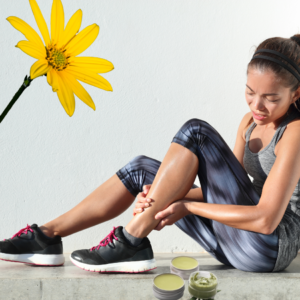
5.3. Best Recovery Assistance for Athletes – Arnica oil.
Recall, Arnica is a powerful herb that can help with athletic recovery and muscle pain, but it is important to use it cautiously and follow best practices to avoid any adverse effects. Always prioritize safety and consult with a healthcare professional if you have any concerns about using Arnica.
- Bruise Relief – Your dermatologist-tested arnica gel for bruising & swelling infuses your skin with recovery-enhancing proteins and vitamins. Restore lost moisture, encourage collagen production, and address wound, burn, or post-surgery scars with a scientifically formulated cream that really works.
- Arnica’s Power – Going beyond the proven beneficial effects of the Arnica Montana flower, your bruise cream gives you several building blocks to repair + rejuvenate skin and muscle at the cellular level. Arnica Montana reduces the appearance of bruises & scars, while relieving swelling resulting from surgery or trauma. Moisturizes, protects, and strengthens fragile skin for faster recovery & results.
- Stronger Skin – Your Bruise Relief cream helps restore skin with L-Arginine amino acid and Vitamin K. Apply daily to see an increase in skin strength and glow, and a decrease in bruisability. Each pure ingredient in our bruise healing cream serves a specific purpose designed to deliver real results. Arnica cream for bruising made with Arnica Montana.
- Powerful Ingredients - Miracle Plus Arnica gel bruise cream combines ingredients such as Aloe Vera, Papaya and Grapefruit extracts to help maintain a hydrated and clear complexion. Gotu Kola stimulates skin repair while Collagen is known to improve overall skin tone and firmness. Witch Hazel and Calendula work to reduce swelling while promoting rapid skin regeneration.
- Pure, Potent, Proven – Trust in a Clinically-Tested, Dermatologist-Tested, Allergy-Tested, formula with a 20+ year track record of success. Your paraben-free, non-greasy, & non-irritating bruise cream is made in the U.S. under strict guidelines for quality and safety. Never tested on animals.
- This homeopathic medicine helps temporarily relieve muscle pain & stiffness due to minor injuries, overexertion & falls. Also great for pain, swelling, & discoloration from bruises
- Our moisturizing cream formula is unscented & paraben-free
- This popular homeopathic medicine temporarily relieves muscle pain & stiffness without unwanted drowsiness
- This moisturizing cream is great for relief following an injury, intense workout, or general overexertion
- Our non-scented cream's soothing effects makes it ideal for massaging into sore muscles and joints
- ARNICA and VITAMIN K! Bruises, purpura, cuts, new scars, new stretch marks, and skin cracks - from cuticle moisturizing to sun damage relief, Skintensive's non-greasy formula gives your skin the loving attention it deserves.
- MORE THAN ARNICA Restore lost moisture, and address the appearance of wound, burn, or post-surgery scars with the very best cream. For best results, use on new bruises and healed scars
- OUR SOOTHING MOISTURIZER features Arnica Flower Extract along with Vitamins K, C, and E in a coconut oil base. Clinically tested, allergy tested, and non-irritating. Cruelty Free.
- DEVELOPED BY HARVARD-TRAINED DERMATOLOGISTS. Advanced strength prevention designed by two Harvard trained dermatologists. This topical salve offers the very best therapeutic care, Made in the USA with thoughtfully sourced components from around the world.
- TURN BACK THE HANDS OF TIME on damaged skin across hands, arms, legs, body or face - with no residue. Skintensive is comfortable and effective for fragile and thin skin as well as scar- and bruise-afflicted skin. Looking for the original formula? Check out our Skintensive Daily Moisturizing Cream!
6. Summing up
To wrap up, Arnica is truly the perfect herb for athletic recovery and muscle pain. Its natural anti-inflammatory and pain-relieving properties make it a great alternative to traditional medications. Whether you are a professional athlete or just someone looking to ease muscle soreness after a workout, Arnica can be a safe and effective solution. So next time you’re feeling achy or sore, consider giving Arnica a try and see the benefits for yourself!
- ARNICA FOR PAIN: This homeopathic medicine helps temporarily relieve muscle pain & stiffness due to minor injuries, overexertion & falls. Also great for pain, swelling, & discoloration from bruises.
- TOPICAL PAIN RELIEF: Our non-greasy, water-based formula absorbs quickly & is unscented & paraben-free. This cooling gel is great for relief following an injury, intense workout, or general overexertion.
- PLANT-BASED ACTIVE INGREDIENT: The Arnica montana plant is a natural pain reliever. This popular homeopathic medicine temporarily relieves muscle pain & stiffness without unwanted drowsiness.Fluoride-Free
- HOMEOPATHIC MEDICINE uses highly diluted biological, botanical, or mineral substances to relieve symptoms. Our tablets, pellets, & topical treatments work with your body without the risk of contraindications, or known drug interactions.
- THE BOIRON PROMISE: We believe there’s more than one way to feel better. Since 1932, we have been committed to providing quality medicines. As a world leader in homeopathy, our passion is your health. Our promise is your satisfaction.
- ARNICA FOR PAIN: This homeopathic medicine helps temporarily relieve muscle pain & stiffness due to minor injuries, overexertion & falls. Also great for pain, swelling, & discoloration from bruises.
- EASY TO TAKE: Arnicare pellets provide general pain relief & may be combined with an Arnicare topical for targeted relief. Our pellets quickly dissolve under the tongue; no water or chewing required.
- PLANT-BASED ACTIVE INGREDIENT: The Arnica montana plant is a natural pain reliever. This popular homeopathic medicine temporarily relieves muscle pain & stiffness without unwanted drowsiness.
- HOMEOPATHIC MEDICINE uses highly diluted biological, botanical, or mineral substances to relieve symptoms. Our tablets, pellets, & topical treatments work with your body without the risk of contraindications, or known drug interactions.
- THE BOIRON PROMISE: We believe there’s more than one way to feel better. Since 1932, we have been committed to providing quality medicines. As a world leader in homeopathy, our passion is your health. Our promise is your satisfaction.
- ARNICA FOR PAIN: This homeopathic medicine helps temporarily relieve muscle pain & stiffness due to minor injuries, overexertion & falls. Also great for pain, swelling, & discoloration from bruises.
- TOPICAL PAIN RELIEF: Our non-greasy, light & soothing cream is unscented & paraben-free. This moisturizing formula is great for relief following an injury, intense workout, or general overexertion. Note: Won’t mask symptoms of a more serious condition
- PLANT-BASED ACTIVE INGREDIENT: The Arnica montana plant is a natural pain reliever. This popular homeopathic medicine temporarily relieves muscle pain & stiffness without unwanted drowsiness.
- HOMEOPATHIC MEDICINE uses highly diluted biological, botanical, or mineral substances to relieve symptoms. Our tablets, pellets, & topical treatments work with your body without the risk of contraindications, or known drug interactions.
- THE BOIRON PROMISE: We believe there’s more than one way to feel better. Since 1932, we have been committed to providing quality medicines. As a world leader in homeopathy, our passion is your health. Our promise is your satisfaction.
7. FAQ
Q: What is Arnica?
A: Arnica is a perennial herb that belongs to the sunflower family. It is known for its powerful healing properties and has been used for centuries to treat various ailments.
Q: How does Arnica help with athletic recovery?
A: Arnica contains anti-inflammatory properties that can help reduce pain, swelling, and bruising associated with sports injuries. It also promotes circulation, which speeds up the healing process.
Q: Can Arnica be used for muscle pain?
A: Yes, Arnica is often used topically to relieve muscle pain and soreness. Its natural analgesic properties make it an effective treatment for strains, sprains, and muscle aches.
Q: Are there any precautions to consider when using Arnica?
A: Arnica should not be ingested as it can be toxic in large doses. It is important to follow the recommended dosages and avoid using it on broken skin or open wounds. Consult a healthcare professional before using Arnica, especially if you are pregnant or breastfeeding.
Q: Where can I find Arnica products for athletic recovery?
A: Arnica products such as creams, gels, and ointments are available at most health food stores, pharmacies, and online retailers. Look for reputable brands that use high-quality Arnica extracts for the best results.
- Trusted by medical professionals and everyday people, LifeVac has saved thousands of lives and is safe and effective to use in choking emergencies.
- LifeVac will never push the obstruction deeper into the victim’s airway as it features a one-way valve which ensures that when the device is used, it will not force the obstruction deeper into the airway of the victim.
- Easy to Use: LifeVac was designed to be simple to operate: It’s as easy as Place, Push, Pull. Our life-saving device can be self-administered in the event one experiences a choking emergency when alone.
- Never Expires: LifeVac will not have to be replaced unless used to save a life. Masks should be checked periodically and replaced every two to three years.
- One kit provides protection for your entire family, including both children and adults and is HSA / FSA approved.
- Reliable Choking Rescue for Home Safety:Crafted from high-quality silicone, the AmzBoom Anti-Choking Device offers a non-invasive and gentle solution for choking emergencies. choosing a top-tier safety device,you can provide your family with peace of mind, knowing you're prepared to protect your loved ones when they need it the most.
- Comprehensive Solution for All Ages:Equipped with three masks—two for adults (one for real use and one for practice) and one for children—the AmzBoom Anti-Choking Device includes a training manual to help users feel confident and prepared.Practice before an emergency to ensure quick, effective use.
- User-Friendly Design for Rapid Emergency Response:With its ergonomic plunger and powerful suction, the AmzBoom device is designed for easy operation by anyone, anywhere.An essential addition to any first aid kit, it’s ready to deliver safe, effective suction during critical moments.
- Compact, Portable & Travel-Friendly:Lightweight and durable, the AmzBoom device is perfect for home, car, or travel use. It offers a fast, reliable alternative to traditional choking methods, making it a must-have for family safety. Add this life-saving tool to your cart to ensure you’re always prepared for an emergency.
- Long-Lasting Reliability with Extended Shelf Life:Built to withstand long-term use, the AmzBoom Anti-Choking Device offers a shelf life of 3-5 years.It’s designed for easy use by anyone, providing long-term peace of mind and reliable protection for you and your family.Protect your loved ones today with this essential emergency tool.
- ArixMed suction rescue device includes an ArixMed suction device with a one-way valve, a pediatric mask, two adult masks (one for practical use, one for practice), and a set of instructions, all packaged in a durable travel bag.
- ArixMed is a non-invasive suction rescue device designed to save lives in cases of airway obstruction. Take action, have the appropriate equipment ready, and protect yourself and your loved ones.
- Choking Suction Devices are small, lightweight and easy to use - simple enough that you can use them on yourself in a choking emergency. They can be carried in a backpack, glove box or first aid kit for home, school, travel and outdoors.
- This kit is suitable for both children and adults. The suction duration is extremely short, making ArixMed both safe and effective. This suction device serves as a life-saving tool, playing a significant role in emergency situations or special circumstances involving airway obstruction. Whether you are looking to upgrade your first aid kit or simply preparing for any emergency, it can be incredibly beneficial!
- Unless used to save a life, there is no need to replace the ArixMed device. Regularly inspect the masks, and it is strongly recommended to replace them every two to three years.
Marjoram – Transform Your health and Cooking with this Miracle Herb
Discover the Hidden Health Benefits of Tarragon
Heal Your Gut with Slippery Elm – A Dietary Must-Have
Discover the Benefits of Arnica – Natures Pain Reliever
How Can Cinnamon Control Blood Sugar Levels And Reduce inflammation
Worlds’s most expensive tree bark
- AED defibrillator designed for ease of use and prompt response
- Step-by-step voice commands and CPR guidance provide real-time guidance
- Easily converts to an AED trainer when you attach training pads (sold separately)
- Slim AED Carry Case accommodates defibrillator and paramedic scissors
- AED ships with: HeartStart Home AED Defibrillator, pre-installed battery, pre-installed adult SMART pads cartridge, quick setup guide, maintenance booklet, quick reference guide, owner’s manual, Slim Carry Case, and training DVD
- The Prestan Professional AED Trainer outperforms the competition in terms of quality, durability, and training
- The pads contain an integrated switch that detects when the AED Trainer pads are fitted to the manikin torso. During CPR/AED classes, pads can be used at least 25 to 30 times
- Five scenarios, language choice between English and Spanish and adult/child training selection button are included. The product adheres well to all Manikins with no messy residue left behind and is ideal to fully customize able to accommodate any classroom training situation
- Batteries Required--not included
- For Training Purposes Only!
- Philips HeartStart Home and OnSite AED Defibrillator Trainer, a training only device to help responders learn how to use Home and OnSite Defibrillators (sold separately)
- Users can run eight different training scenarios with voice prompts to guide users on appropriate CPR and therapy for treating a simulated victim
- Can be used in conjunction with the Infant/Child SMART Training Pads (sold separately) to simulate scenarios with infants/children
- What’s in the box: HS1 AED Trainer, 1 set of Adult SMART Training Pads and a zippered carry case, as well as instructions for use, a quick reference guide and an external manikin adapter
- Pads are warrantied until expiration date. Other accessories include 1-year warranty
- Compact Size---AED defibrillator storage cabinet is made of industrial-grade Metal Steel Plate and measures 14.1 x 7.8 x 15.7 inches.The material is also easy to clean and can withstand years of wear and tear.
- Quality AED Cabinets---AED Cabinet provides secure storage for your defibrillator and with snap lock available at any time with the AED card can be installed, you can proudly show your AED to see and have this.
- Wall-Mounted AED Storage Cabinet---Equipped with An Emergency Strobe Light and door-controlled alarm & snap lock, stainless steel door handle and AED cards, and has a transparent PC glass window and red lettering for easy visual identification of AED. There are four holes on the back of the cabinet. For wall-mounted installation.
- Alarm Activated When Door Opened---Alarm and flashing light use 9V battery (included). When you press the door button and the door opens, the alarm and flashing strobe light will be activated to remind everyone to pay attention to the emergency situation, the alarm will be issued from 85 to 120 The sound of dBA.
- Versatility---Can easily accommodate most AED equipment, please rest assured that your AED defibrillator can be comfortably installed in this wall-mounted cabinet. It has a universal size, and they are an indispensable supplement to offices, hotels, restaurants, social clubs and other public places.
